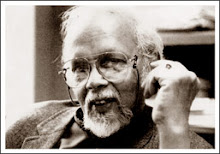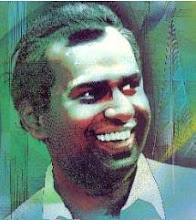|
A five day interactive theatre workshop titled 'Ibsen and his influence on Contemporary Drama' was recently held at the Sarvodaya Development Centre in Bandaragama. The workshop was based on randomly selected four images (images were taken from newspapers and magazines). Two acts of performance were derived from these four images.
However, the significant aspect of these rather impromptu acts of performance was that neither of the workshop leaders nor the participants knew the slightest cue of what there pieces of performances would going to be. The 35 participants who had been selected through 'selective conversations' were divided into two groups and worked on these images for the five days, developing ideas and actions within the frame work of four images.
The ideas derived from the images were developed into two acts. These ten-minute pieces of performances were later shaped and finalized towards the end of the workshop.
One performance is somewhat closer to realistic tradition while the other followed the absurd tradition of drama. The unique experiment of the workshop was the development of different zests, realistic and absurd, based on the same four images.
|
Though these performances were enacted along the bank of picturesque Bolgoda Lake at dusk under floodlights, they were, by no means, theatrical pieces but two pieces of performances.
By coincidence, the two pieces of performance contained minutes characteristics which were closer to the issues and concepts envisaged in Ibsen's work. For instance, there was a character similar to that of Nora has been developed in the realistic form.
Character like Master Builcger was evolved in the absurd form. In the final stages, the participants tried to integrate raw-materials such as dialogues taken from Ibsen's text into the two pieces of performances.
Though the two pieces were created entirely with the material taken from newspapers and magazines, some times the image of Ibsen emerged. It would have been a profitable exercise for both workshop leaders and participants as more emphasis was on the learning process than the outcome of the process which has also not been pre-conceived at any point of the workshop.
The final performances were enacted on the meadow by the Bolgoda Lake at dusk around 6.00 p.m under the lights. Saumya believes that the workshop provided much-needed leverage for process of education and that it would be a smooth commencement rather than an end.
|
Workshop took a dynamic approach where diverse ideas were allowed to clash in an interactive environment. Though it was not common in conventional drama workshops, here the workshop leaders confronted with ideas in an interactive environment which was conducive to such clashes of ideas, a feature lacking in contemporary theatre scene.
The workshop was marked for its significant departure from the traditional sermons-on-the mountain approach where workshop leaders delivered lectures while the participants looked on as if they were disciples. However, here participants were only guided allowing them to make their own creations. Emphasis was on the process rather than the outcome.
It would have been a daunting task for enthusiastic participants and the talented workshop leaders to convert ideas derived from four images into set of acts. What the workshop leaders did was to encourage participants to create the two pieces of performances according to the realistic and absurd traditions.
The amazing outcome was a couple of characters which were similar to those in Ibsen's dramas. Unwittingly Ibsen's ideas and concepts have been developed in those pieces, instead of them being forcibly inserted into them.
Throughout the workshop, Ibsen's pervasive influence has been visible in a most natural manner. It is obvious that contemporary Sri Lankan theatre is greatly influenced by Ibsen and his work. However, the re-reading of Ibsen or de-construction of his work in a post-modern context, is relevant to Sri Lanka, especially in a milieu Sri Lankan youth are greatly influenced by post-modern thinkers such as Stanislavesky and Artaud.
The central question that confronts the present generation is whether it is possible to de-construct Ibsen and re-produce Ibsen's 'modernist' texts and thoughts into 'post-modern hypertext' in order to explore urban realities.
Though Ibsen is present in Sri Lankan theatre through translations and adaptation of his monumental pieces in naturalistic form, it has, perhaps, for the first time that research, into his ideas and concepts is conducted through a process culminating in the creation of two pieces of performances.
These pieces of performances have not been identified as 'theatrical pieces' for the simple reason that they would recall proscenium type performances. The two performances enacted on the meadow of Bolgoda Lake were, though used light sets, not conventional theatrical pieces.
They were, in fact, outcomes of a process of education where the veterans and theatre-enthusiastic participants ventured into the rather forgotten realm of Ibsen and the socio-economic issues he highlighted through his work.
The socio-economic issues depicted in Ibsen's work are as relevant to the contemporary Sri Lankan society as they were in Ibsen's time. Film screening, discussions were also held during the workshop. One of the significant characteristics of the workshop was that workshop encouraged participants to discover their talents and to make their own creations rather than becoming perpetual students.
The 'Ibsenight' project is designed and focuses to research hundred years old Playwright's legacy and the possibility of reproducing the major concepts and thoughts inherited in Ibsen - text in the contemporary performance form.
Although the reproduction of Ibsen in contemporary theatre with Naturalistic form is a common trend, the workshop attempted at re-producing Ibsen's 'modernist' text, thoughts and developing them into 'postmodern hypertext' in order to explore urban realities of Sri Lankan youth.
Piyal Kariyawasam, Ruwanthi De Chickera, Presannajith Abesuriya, Rajitha Dissanayake, Saumya Liyanage and E. M. D. Upali made up the Resident Artists and Mentors while Kaushalya Fernando, Hemasiri Liyanage, Priyankara Ratnayake, Pradeep Chandrasiri and Ranjith Dissanayake were other resource personnel.
The 'Curtain is rising' was organized by SARASAVI MITHORO, the alumina association of the University of Colombo.







































No comments:
Post a Comment